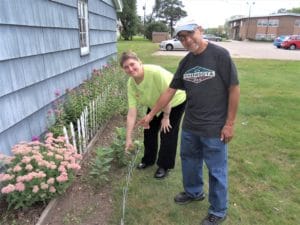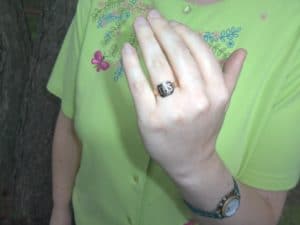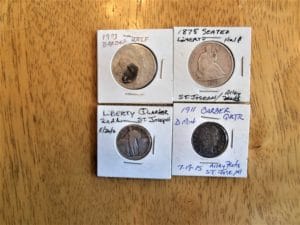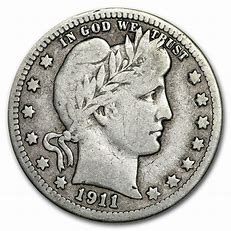by Dennis Dalman
A sense of quickening excitement overcomes Jerry Guerrero of St. Joseph when his metal detector tells him there is something under the dirt right in front of him.
When he digs into the ground, he is always surprised and excited about his “finds” even if they are ordinary objects like old toys, old tools or cast-off items of no particular value. But his excitement really rises, his heart pounds, every time he uncovers an old coin or a gold ring or a necklace pendant.
“I love the surprise element of this hobby,” he said. “It’s thrilling because you never know what you’re going to find.”
One of Guerrero’s recent happy finds is a gold ring belonging to Sister Tamra Thomas, who lives in a rental house in St. Joseph along with other nuns, one of them being 92-year-old Sister Phyllis Plantenburg.
One day, Guerrero stopped at the house and asked if he could do metal detecting in that yard. Sister Phyllis said yes, of course he could. He didn’t find much of anything noteworthy. But weeks later, Sister Phyllis saw Guerrero metal detecting in a nearby yard and walked over to talk with him about the “lost ring.”
It happened last fall just before an overnight snowstorm was predicted. Sister Tamra decided to remove the little wire fence in a strip of butterfly garden behind the garage so no shovelers would damage it. On a cold evening, she did the task. But later that night, she noticed her special ring was missing from her left hand. It must have come off in the butterfly garden, she thought. She and others scoured the garden, even uprooting some of the plants and another small picket fence closer to the garage. She put all the debris on the lawn, raked through it, looked closely, scrutinizing every bit of the garden and the lawn. Alas, no ring.
It was very disappointing because the ring was given to Sister Tamra at a final profession ceremony just last year at St. Benedict Monastery. It symbolizes the lifelong covenant between the person choosing the profession, the monastic community she is joining and God. The gold ring has a black signet with the letters IHS on it, the Latin initials for a phrase for “Jesus Savior of Mankind.”
When Sister Phyllis asked Guerrero if he and his detector could help pinpoint the lost ring, he said yes, of course. Within minutes, passing his detector over the soil in the butterfly garden, a signal was emitted. Guerrero brushed off a thin layer of dirt and “voila!” there was a sparkle of gold – the ring.
Sister Phyllis – and Sister Tamra, of course – were elated by the find and most grateful to Guerrero for his kind help.
It’s the second ring Guerrero found via special request. Last year, he found a young man’s wedding band.
However, it’s old coins – not so much rings – that give him a special thrill every time he spies a glint of silver or copper in the ground. His precious coin collection now includes the following stunning finds, most of them retrieved from the ground right in St. Joseph:
• An 1875 Liberty half-dollar and a 1911 quarter, both found the summer before last at an excavation site on College Avenue in downtown St. Joseph.
• A 1903 Barber half-dollar, found in a yard on Minnesota Street. (The coin and others are known as “Barber” because of Charles E. Barber, an engraver of coin designs for the U.S. Bureau of the Mint. His designs were minted in the millions on nickels, dimes, quarters and half-dollars from 1892 to 1916).
• A 1904 Barber half-dollar and a 1906 Barber half-dollar, found in the same yard of a house in St. Joseph.
• A 1907 Indian-head penny in a St. Joseph yard.
• A 1943 Walking Liberty silver dollar found at Benton Beach on Little Rock Lake near Rice.
Most really old coins are found typically from 5 to 8 inches below the ground surface. Guerrero has a knack for retrieving them without damaging a lawn. He makes a horseshoe-shaped cut into the soil, then, once the object is retrieved, the dirt and grass can be placed back perfectly.
He has three detectors, which work via electromagnetism. An electromagnetic field is emitted by the detector’s bottom coil, which in turn sets off an electromagnetic response from a metal object, thus alerting the presence of a metal object in the ground.
Guerrero started his metal detecting hobby just three years ago. It is, he said, a most relaxing, interesting hobby that also is a form of exercise.
Born in Hutchinson, Guerrero moved to St. Cloud in 1979, then he and his wife, Lucy, moved to St. Joseph in 1988. He is the owner of Brush and Roll Painting, (interior/exterior painting); and of E-Z Clean Pressure Washing Service. He also does deck refinishing upon request. The couple has two children – Lorena of St. Cloud; and Jeremiah, 37, Sauk Rapids. They have two grandchildren (Jeremiah’s children Daren, 15; and Brenna, 11). Darren likes to go on metaldetecting expeditions with his grandfather.
Guerrero is careful always to ask permission before treasure-hunting on private property. He is more than willing to help people, free of charge, to help locate lost rings or other precious-metal jewelry. If he finds unexpected gold objects, however, he shares half the price of the gold with the lot’s owner.
To contact Guerrero, call 320-420-2625 (cell) or (home) 320-363-4260.

Benedictine Sister Tamra Thomas and Jerry Guerrero point to the spot where Guerrero, with the aid of his metal detector, found a gold ring that Thomas had lost.

This is the ring that was lost and found, back on the finger of Sister Tamra Thomas, where it belongs.

Among Jerry Guerrero’s finds are these four coins: a 1903 Barber half-dollar with a mysterious black smudge on it (upper left); an 1875 Seated Liberty half-dollar (upper right); a Liberty quarter (lower left) and a 1911 Barber quarter (lower right).

After meeting in dowtown St. Joseph for an interview with the St. Joseph Newsleader, Jerry Guerrero took a metal detector out of his trunk to explain how it works. He did not actually seek any objects on this tiny patch of ground on Minnesota Street.

This image, from a coin-collecting website, shows an excellent version of a 1911 Barber quarter, which is one of the coins Jerry Guerrero brought to the light of day after years of darkness in the dirt of a St. Joseph yard.



